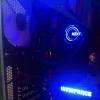-
Posts
61 -
Joined
-
Last visited
Awards
This user doesn't have any awards
Profile Information
-
Gender
Not Telling
System
-
CPU
i7-4790K @ 4.4GHz
-
Motherboard
Asus Z97-E
-
RAM
16GB G.Skill Ripjaws X DDR3-2400
-
GPU
Gigabyte GTX 970 Gaming G1
-
Case
Zalman Z11 Neo
-
Storage
120GB Team Dark SSD, 3TB Seagate Barracuda
-
PSU
Corsair CX600M
-
Display(s)
Dell E2715H 27" IPS monitor
-
Cooling
NZXT Kraken x41
-
Keyboard
Steelseries Apex
-
Mouse
Some random Lenovo wireless mouse
-
Operating System
Windows 10 Enterprise
Recent Profile Visitors
733 profile views
fluffy_ninja's Achievements
-
So my friend pretty much offered to get me anything for under $40 for my computer and I have no clue what to spend it on. I'm thinking a decent headset maybe, but I'm definitely not limited to that. Anyway, anyone know of good headsets or other peripherals that I can get for around $40? Thanks
-
https://www.nzxt.com/product/detail/141-fn-v2-performance-case-fan.html ^^These are awesome
-
Honestly, I've never had any problems with CX power supplies. Maybe I'm just lucky, but they've always worked great for me.
-

Safe to over lock gpu if not boosting voltage?
fluffy_ninja replied to Jesse221's topic in Graphics Cards
It won't effect the lifespan, but if you OC the card and it's not getting enough voltage you're gonna get errors and programs will crash. You can always just try overclocking it and stress test the graphics card and if anything happens give it more voltage. 20MHz isn't gonna do anything though, if you want performance increase start at 100MHz at least. -
Honestly, I've never noticed much of a difference between AMD's and nvidia's same-tier GPUs. I actually borrowed a friend's 390 about a week ago and tried it in my rig and the graphics benchmarks were pretty much identical; depending on the test sometimes one card did marginally better then the other but that's about it.
-
Right, so that makes sense with adaptive, but if I just have 1.225v with a negative offset why is the voltage higher under load? So what's the real difference between adaptive and offset? (Probably a stupid question, but I'm kinda new to overclocking)
-
I'd get rid of one of the hard drives (probably one of the 2tb hdds) and get a 970 instead of a 960. My video editing rig has a 970 and you'll want more than the 2gb of vram that the 960 has.
-
So I set the voltage to 1.225v with a -0.005v offset, and now the voltage drops at idle but under load it seems to max out at 1.266. Shouldn't a negative offset lower the voltage under load?
-
I think you might be right, I'll double check the settings but I think the voltage automatically resets to auto when I switch to offset mode. Thanks
-
What's the benefit to offset and manual voltages when overclocking? Right now, my system has an i7-4790k with a stable overclock of 4.6GHz at 1.225v (static voltage, 1.225v even at idle). Temps are fine, 65 degrees max under full load and around 38 at idle. Here's the thing - if I have the voltage set to offset, my temps drop about 7-8 degrees and voltage drops to about 1.08v at idle, but when stress testing they hit 75-80 degrees and 1.35v. I know that 75 degrees is a safe temperature, I'm more uncomfortable with the 1.35v. Sometimes the voltage will jump that high even under 50% load. Also, I could get a higher overclock with if the voltage is set to manual 1.225 or if I raise it to 1.23. Also, this isn't just my gaming rig, I use it for video editing and 3d rendering, so the computer is usually running at 100% for at least 45 minutes every day (I don't know how significant that is, but I figured it's worth mentioning). So should I stick with manual voltage or is it better to use offset?
-
Heart of Gold, because Hitchhikers is awesome. (My OS drive is the infinite improbability drive and my data drive is the hyperspace drive)
-

Adding drive to expand existing volume
fluffy_ninja replied to fluffy_ninja's topic in Storage Devices
What's the disadvantage to raid? Or the advantage to keeping it as two separate drives? -
I currently have a 120Gb ssd that I'm using for my OS, but it's starting to run low on space. I want to get another 120Gb ssd and be able to combine it to my existing drive without having to format anything. I know that I would probably be able to do it with a RAID array, but I don't know too much about them. So here's my question: If I use RAID, what type of array should I use? Also, is there a better way to do this without a RAID array? Thanks.
-
nah, just a hiccup. Usually nothing to worry about.



